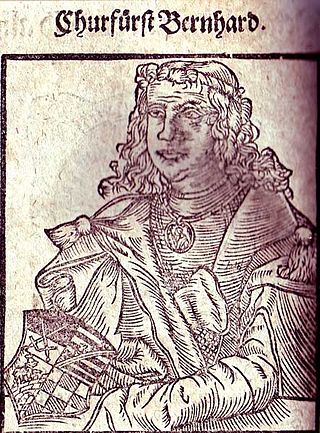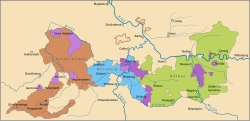The House of Ascania was a dynasty of German rulers. It is also known as the House of Anhalt, which refers to its longest-held possession, Anhalt.

The history of Saxony-Anhalt began with Old Saxony, which was conquered by Charlemagne in 804 and transformed into the Duchy of Saxony within the Carolingian Empire. Saxony went on to become one of the so-called stem duchies of the German Kingdom and subsequently the Holy Roman Empire which formed out of the eastern partition of the Carolingian Empire. The duchy grew to become a powerful state within the empire, ruling over much of what is now northern Germany, but following conflicts with the emperor it was partitioned into numerous minor states, including the Principality of Anhalt, around the end of the 12th century and early 13th century. The territories of the Duchy of Saxony, the Principality of Anhalt, and their successors are now part of the modern German state of Saxony-Anhalt.

Anhalt-Dessau was a principality of the Holy Roman Empire and later a duchy of the German Confederation. Ruled by the House of Ascania, it was created in 1396 following the partition of the Principality of Anhalt-Zerbst, and finally merged into the re-united Duchy of Anhalt in 1863. The capital of the state was Dessau in present-day Saxony-Anhalt.

Anhalt-Bernburg was a principality of the Holy Roman Empire and a duchy of the German Confederation ruled by the House of Ascania with its residence at Bernburg in present-day Saxony-Anhalt. It emerged as a subdivision from the Principality of Anhalt from 1252 until 1468, when it fell to the Ascanian principality of Anhalt-Dessau. Recreated in 1603, Anhalt-Bernburg finally merged into the re-unified Duchy of Anhalt upon the extinction of the line in 1863.
Magnus I (1304–1369), called the Pious, was duke of Brunswick-Lüneburg.

The Diocese of Halberstadt was a Roman Catholic diocese from 804 until 1648. From 1180, the bishops or administrators of Halberstadt ruled a state within the Holy Roman Empire, the prince-bishopric of Halberstadt. The diocesan seat and secular capital was Halberstadt in present-day Saxony-Anhalt.

Falkenstein/Harz is a town in the Harz district, in Saxony-Anhalt, Germany. It was created in 2002 by merging the town of Ermsleben with the former municipalities of Endorf, Meisdorf, Neuplatendorf, Pansfelde, Reinstedt und Wieserode. The new community was named after Falkenstein Castle.

The Principality of Anhalt was a State of the Holy Roman Empire, located in Central Germany, in what is today part of the federal state of Saxony-Anhalt.

Anhalt-Zerbst was a principality of the Holy Roman Empire ruled by the House of Ascania, with its residence at Zerbst in present-day Saxony-Anhalt. It emerged as a subdivision of the Principality of Anhalt from 1252 until 1396, when it was divided into the principalities of Anhalt-Dessau and Anhalt-Köthen. Recreated in 1544, Anhalt-Zerbst finally was partitioned between Anhalt-Dessau, Anhalt-Köthen, and Anhalt-Bernburg in 1796 upon the extinction of the line.

Bernhard, a member of the House of Ascania, was Count of Anhalt and Ballenstedt, and Lord of Bernburg through his paternal inheritance. From 1180 he was also Duke of Saxony.

Henry I, a member of the House of Ascania, was Count of Anhalt from 1212 and the first ruling Anhalt prince from 1218 until his death.

Henry II, Prince of Anhalt-Aschersleben was a German prince of the House of Ascania and ruler of the principality of Anhalt-Aschersleben.

Otto I, Prince of Anhalt-Aschersleben was a German prince of the House of Ascania and ruler of the principality of Anhalt-Aschersleben.
Henry III, Prince of Anhalt-Aschersleben was a German prince of the House of Ascania and ruler of the principality of Anhalt-Aschersleben.

Otto II, Prince of Anhalt-Aschersleben was a German prince of the House of Ascania and the last ruler of the principality of Anhalt-Aschersleben.
Bernhard I, Prince of Anhalt-Bernburg was a German prince of the House of Ascania and ruler of the principality of Anhalt-Bernburg.

Bernhard II, Prince of Anhalt-Bernburg, was a German prince of the House of Ascania and ruler of the principality of Anhalt-Bernburg.

Matilda of Brandenburg, a member of the House of Ascania, was first Duchess consort of Brunswick-Lüneburg from 1235 to 1252 by her marriage with the Welf duke Otto the Child.
Albert II of Brunswick-Lüneburg, a member of the House of Welf, was Prince-Bishop of Halberstadt from 1325 until his death. His regnal numbers indicate that he was the second Bishop Albert of Halberstadt. His reign can be characterized as an almost unbroken series of conflicts with the Pope, his cathedral chapter, the city of Halberstadt and various neighbouring Lords and Princes.
















